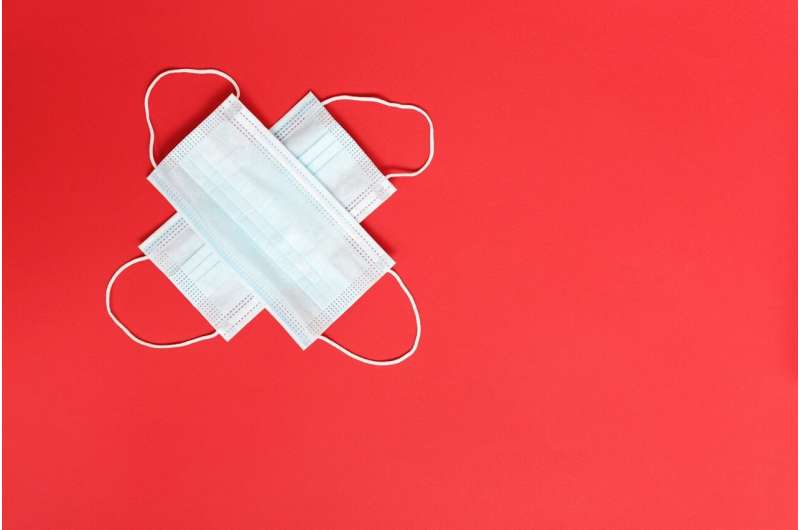Graphene-coated face masks: COVID-19 miracle or another health risk?

As a and researcher, I understand the importance of to prevent the spread of the coronavirus. So I am intrigued that some mask manufacturers have begun adding graphene coatings to their face masks to inactivate the virus. Many are incapacitated by graphene in laboratory studies, including .
Because SARS CoV-2, the coronavirus that causes COVID-19, can , people who touch the mask and then rub their eyes, nose, or mouth may risk getting COVID-19. So these manufacturers seem to be reasoning that graphene coatings on their reusable and disposable face masks will add some anti-virus protection. But in March, the removed these masks from schools and daycare centers after Health Canada, Canada's national public health agency, warned that inhaling the graphene could lead to asbestos-like lung damage.
Is this move warranted by the facts, or an over-reaction? To answer that question, it can help to know more about what graphene is, how it kills microbes, including the SARS-COV-2 virus, and what scientists know so far about the potential health impacts of breathing in graphene.
How does graphene damage viruses, bacteria and human cells?
Graphene is a thin but strong and conductive . There are three ways that it can help prevent the spread of microbes:
- Microscopic graphene particles have that mechanically damage viruses and cells as they pass by them.
- Graphene is negatively charged with highly mobile electrons that electrostaticly trap and inactivate some viruses and cells.
- Graphene causes cells to generate oxygen free radicals that can damage them and .
Why graphene may be linked to lung injury
Researchers have been studying the potential negative impacts of inhaling microscopic graphene on mammals. In one 2016 experiment, experienced localized lung tissue damage, inflammation, formation of granulomas (where the body tries to wall off the graphene), and persistent lung injury, similar to what occurs when humans . A different study from 2013 found that when , the cells were damaged.
In order to mimic human lungs, scientists have developed biological models designed to simulate the impact of high concentration aerosolized graphene—graphene in the form of a fine spray or suspension in air—on industrial workers. One such study published in March 2020 found that a to graphene induced inflammation and weakened the simulated lungs' protective barrier.
It's important to note that these models are not perfect options for studying the dramatically lower levels of graphene inhaled from a face mask, but researchers have used them in the past to learn more about these sorts of exposures. A study from 2016 found that a could move down a simulated mouth and nose passages and penetrate into the lungs. A 2018 study found that brief exposure to a lower amount of aerosolized graphene did not notably in a model.
From my perspective as a researcher, this trio of findings suggest that a little bit of graphene in the lungs is likely OK, but a lot is dangerous.
Although it might seem obvious to compare inhaling graphene to the well-known harms of breathing in asbestos, the two substances behave differently in one key way. The body's natural system for disposing of foreign particles cannot remove asbestos, which is why long-term exposure to asbestos can lead to the cancer . But in studies using to measure the impact of high dose lung exposure to graphene, the body's natural disposal system does remove the graphene, although it occurs very slowly over 30 to 90 days.
The findings of these studies shed light on the possible health impacts of breathing in microscopic graphene in either small or large doses. However, these models don't reflect the full . So the strength of the evidence about either the benefit of wearing a graphene mask, or the harm of inhaling microscopic graphene as a result of wearing it, is very weak.
No obvious benefit but theoretical risk
Graphene is an intriguing scientific advance that may speed up the demise of COVID-19 virus particles on a face mask. In exchange for this unknown level of added protection, there is a theoretical risk that breathing through a graphene-coated mask will liberate graphene particles that make it through the other filter layers on the mask and penetrate into the lung. If inhaled, the body may not remove these particles rapidly enough to prevent lung damage.
The health department in Quebec is erring on the side of caution. Children are at very low risk of COVID-19 mortality or hospitalization, although they may infect others, so the theoretical risk from graphene exposure is too great. However, adults at may choose to accept a small theoretical risk of long-term lung damage from graphene in exchange for these potential benefits.
Provided by The Conversation
This article is republished from under a Creative Commons license. Read the .![]()




















